|
That night in 1976, at the Paris Opéra Comique, we knew that history was in the making, in a theater piece that consisted of tableaux vivants almost devoid of words, accompanied by a score of pulsing, uplifting chords that would give Einstein on the Beach the label "opera." Theater without declamation, without dialogues, without acting. Opera without a plot, without arias, recitatives, duets, even without an orchestra, unless you counted the small band of amplified keyboards, winds and solo violin as an orchestra. There were acts and entr'actes but no intermissions for almost five hours; there were actors, but were they actors? They moved in slow-motion and, instead of acting, exuded expressive power by doing… mostly nothing. Were they men or were they women? With their uniform grey pants and suspenders, white shirts, ponytails or cropped hair they sometimes only revealed late in the game that they were the opposite of what you had assumed at first. It sometimes came across only when you heard their voices, and even then you could have your doubts. We had just entered the glorious age of the androgynous.
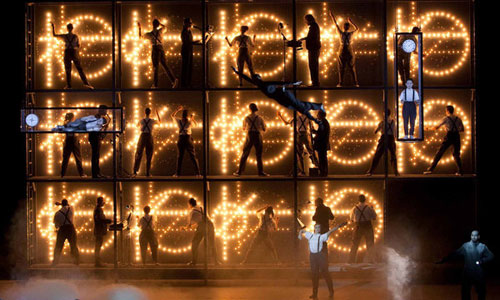 |
Among theater people like myself, the ritualized slow motion, interspersed with occasional hectic, staccato outbursts of movement, was the already familiar "stage language" of Robert ("Bob") Wilson who had made several appearances in Paris since 1971, among them A Letter to Queen Victoria (with a spectacular ending on a beach), in 1974. A new element in Einstein on the Beach was something akin to dancing: endless diagonals of springy back-and-forth-stepping by a single woman in pants and suspenders (dancer and choreographer Lucinda Childs). A few intermezzi of abstract group choreography (by Wilson's lover Andy deGroat) broke the spell of slow motion, highlighting the strong rhythmic beat of the music. I remember the little boy high on top of a crane, holding a glow-square in one hand, hovering immobile for what seemed like an eternity, until you noticed the paper swallows sailing down from him every now and then (I was never able to catch him in the act). The big stage was almost empty; in front, a man in a red lumberjack was busily writing words and calculations on an invisible blackboard. At the back, a huge, dusty cut-out of a 19th century steam locomotive slowly pushed its body into the space and slowly recoiled again; a man crossed the stage with spastic, staccato arm movements as if he embodied the steam engine mechanics. The dancer in her unerring diagonals back-and-forth was bouncing her ponytail and holding up a pen or pencil like a triumphant piece of evidence. Evidence of what? The writing on the wall of a new era? A large pink conch on the stage floor was picked up by a dancer/actress and radiantly listened to. Was she hearing the cosmic equivalent to the triadic harmonies of Philip Glass? A beam of neon light descended elevator-like mid-stage and lifted off again. What was this? Space-age magic? A hallucinogenic "trip"?
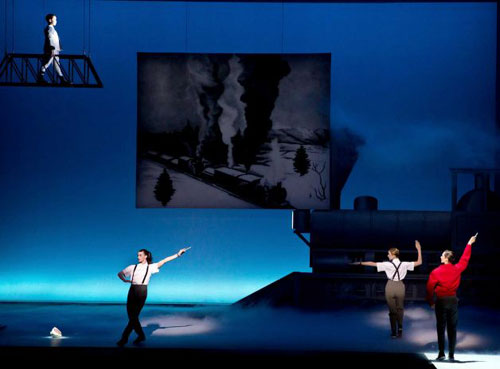 |
Philip Glass's ebbing and swelling organ harmonies in mostly major keys were taken by most people back then as an invitation to get into a state, get stoned, meditate, experience the rapture of something entirely mysterious and momentous. We would wander in and out of the theater, puff on a joint, with little worry of missing much. Upon returning, the same scene would still be going on and nothing would have advanced while everything was advancing in minute increments of variation. Albert Einstein on a beach? We did not try to puzzle out the more arcane symbolisms of either Einstein or the never appearing beach. It was obviously a surreal game of free associations, not biography. But in hindsight I am sure we experienced Albert Einstein's presence in full blast that night, as everything became relative: time and motion, suspense of time and motion, boredom and surprise, meaning and meaninglessness, symbolism and emptiness, music as a mathematical event, opera as theater, theater as its own subversion and reinvention.
That said, the reinvention was no "big bang" event; Einstein on the Beach was no solitary, isolated phenomenon. The theater revolution of the seventies was going on in different places, following Artaud, Brecht, Beckett, The Living Theater, Peter Brook and Grotowski. In New York, there had been the avant-garde of John Cage and Merce Cunningham. Richard Foreman was doing related experiments and in Germany, Pina Bausch was right then inventing "dance theater." Her operatic Bluebeard — While Listening To A Taped Recording Of Bela Bartok's "Duke Bluebeard's Castle"(1977) could also have stood in for the entire period of subversion of the classic bourgeois theater. But Bausch had a disturbing, emotional message (violence against women) whereas Wilson-Glass's opera did not. Einstein was the perfect Rohrschach puzzle of a work that every spectator, every era would have to puzzle out again. Its demands of meditative concentration, its obscure scenes would have to be worked out and reclaimed anew. 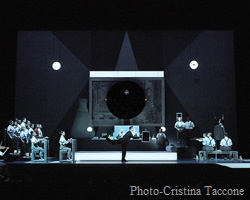 Wilson's alienated, fragmented images and abstractions made the piece seem timelessly modern and, in hindsight, prophetically post-modern -- an ambitious monument geared for a mythical afterlife. Its repetitiveness and lengthiness (often perceived as exasperating) made it controversial: one French critic called Einstein "a perfect cure for insomniacs." Other, more cynical responses suggested that if emotion was not permitted to the modern artist, at least deliver a puzzle dense enough to keep the mind hard at work; make it monumental enough so the puzzle – like the pyramids and sphinxes of old – creates astonishment; make sure it calls for admiration in its perfect execution and, in its unfathomable alien otherness, spiritual awe. Wilson's alienated, fragmented images and abstractions made the piece seem timelessly modern and, in hindsight, prophetically post-modern -- an ambitious monument geared for a mythical afterlife. Its repetitiveness and lengthiness (often perceived as exasperating) made it controversial: one French critic called Einstein "a perfect cure for insomniacs." Other, more cynical responses suggested that if emotion was not permitted to the modern artist, at least deliver a puzzle dense enough to keep the mind hard at work; make it monumental enough so the puzzle – like the pyramids and sphinxes of old – creates astonishment; make sure it calls for admiration in its perfect execution and, in its unfathomable alien otherness, spiritual awe.
I took a workshop with Wilson in 1974 and saw the director at work, guiding and commanding (without words) several dozen actors to move in slower than slow motion. 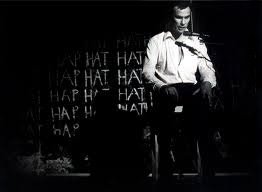 He was a strange fellow, this young Bob Wilson, a "brother from another planet," with the aura of genius, who apparently was intimately connected to autistic and trauma-handicapped youth but less, much less connected to the rest of us. After the première in Avignon he was known to have answered critics by cackling like a bird. Since then, the artist who has become one of the foremost theater directors in Europe (and beyond) has been studied in books and documentaries. We know he had an auditory speech-processing disorder as a child that prevented him from connecting words with meaning. In Katarina Otto-Bernstein's book Absolute Wilson (2006) he reveals that his mother was "a beautiful, intelligent, cold and distant woman" who "sat beautifully in chairs" and did not engage with him. Parts of this personal "drama of the gifted child" (Alice Miller) was palpably inspiring Deafman Glance, the sumptuous stage-play that had first introduced Wilson's work in Paris, in 1971, and created a European sensation. He was a strange fellow, this young Bob Wilson, a "brother from another planet," with the aura of genius, who apparently was intimately connected to autistic and trauma-handicapped youth but less, much less connected to the rest of us. After the première in Avignon he was known to have answered critics by cackling like a bird. Since then, the artist who has become one of the foremost theater directors in Europe (and beyond) has been studied in books and documentaries. We know he had an auditory speech-processing disorder as a child that prevented him from connecting words with meaning. In Katarina Otto-Bernstein's book Absolute Wilson (2006) he reveals that his mother was "a beautiful, intelligent, cold and distant woman" who "sat beautifully in chairs" and did not engage with him. Parts of this personal "drama of the gifted child" (Alice Miller) was palpably inspiring Deafman Glance, the sumptuous stage-play that had first introduced Wilson's work in Paris, in 1971, and created a European sensation.
Deafman Glance was entirely without verbal language and even more slow-motioned; it was almost entirely performed in silence on a stage covered with beach sand. 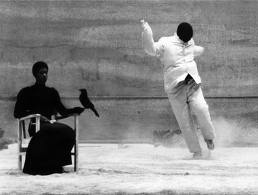 The seven-hour piece about the trauma of infanticide -- centered around the stillness and inarticulate screams of a deaf-mute black boy -- was packed with emotion and seemed intensely personal. It was hard to fathom that the same man had created both Deafman Glance and Einstein on the Beach. I have always deplored Wilson's disappearance behind a screen of austere distanciation (some called it Brechtian), his turn to the cerebral and abstract. A whole emotional dimension was lost in this evolution (see my review of The Black Rider from 2004). I nevertheless greatly admired the modernist relevance of his cutting-edge versions of the Wagnerian Gesamtkunstwerk. Wilson, the artist-director-painter-sculptor-set-designer-choreographer-lighting-designer, etc., involved in every aspect of his cool stagecraft, obsessed with the utmost perfectionism. The seven-hour piece about the trauma of infanticide -- centered around the stillness and inarticulate screams of a deaf-mute black boy -- was packed with emotion and seemed intensely personal. It was hard to fathom that the same man had created both Deafman Glance and Einstein on the Beach. I have always deplored Wilson's disappearance behind a screen of austere distanciation (some called it Brechtian), his turn to the cerebral and abstract. A whole emotional dimension was lost in this evolution (see my review of The Black Rider from 2004). I nevertheless greatly admired the modernist relevance of his cutting-edge versions of the Wagnerian Gesamtkunstwerk. Wilson, the artist-director-painter-sculptor-set-designer-choreographer-lighting-designer, etc., involved in every aspect of his cool stagecraft, obsessed with the utmost perfectionism.
Revisiting the piece now confirmed my earlier impressions and added a few new ones. A lot has been written about the many failed attempts of a revival and the remarkable resurrection of Einstein on the Beach with its present world tour. My esteemed colleague Karren Alenier (read it here) has provided a thorough backdrop and look at the architecture of the opera. I will limit my notes to a few scenic observations.
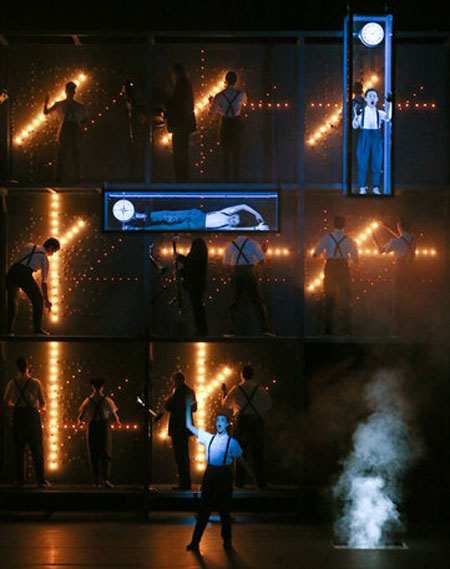 |
The frequent references to Albert Einstein seemed obvious now -- the pants and suspenders of everyone onstage; the wildly wigged violinist above the pit; the references to Einstein's using the example of a train to explain relativity (from different frames of reference, there can never be agreement on the simultaneity of events); or the elevators alluding to his theories about free fall. What struck me anew was how funny many of the scenes and image are. The two little "Einsteins" in their vertical as well as horizontal elevators in the Spaceship sequence seem to be species stuck in the glass tubes of a science lab and shot into space. The women stenographers in the trial scenes lift their behinds from their chairs every now and then to scratch their butts, while the jurors (all in Einstein uniform) scratch their heads in unison and a spectator in the courtroom keeps shaking his head – something the audience might also want to do. One of the women regularly turns to look at the audience with the perfect Pina Bausch look: flirtatiously and accusingly implying complicity. Hilarious, scenically speaking, is the outcome of all the mad-cap agitation of the Spaceship/science lab with its many light-bulb-blinking cubicles (hello, Robert Lepage) and its vocal fury: the stage suddenly goes empty and dark and a little toy spaceship makes its way upward all alone across the stage.
As I had originally, I saw the small boy high up on the crane as a signal of a thematic connection with Wilson's Deafman Glance and other earlier works. There is something childlike and consciously naïve about the still life scenes of Einstein – like the card-board cut-out locomotive that finally drives out to show its full body, with a conductor right out of a 19th century picture-book calmly puffing on his pipe. The dreamy, childlike elements turn unavoidably into nightmares. In one of the most intense scenes between dream and nightmare, we see the back of a train crossing through the night. A powerful black woman, Helga Davis, replacing the actress Sheryl Sutton from the original cast (who dominated Deafman Glance with her extraordinary, wordless presence) appears in the train compartment together with a white man. Both are in evening attire. They slowly make their way from the compartment out onto the open platform and back again in a long, entirely mute "dialogue." Their tense, minute exchanges of gestures, gazes, and body positions are accompanied by a continuously growing moon. Like in Deafman Glance, the failures of communication are packed with suspense and take a shocking turn to murder, ending with the silent scream of the man.
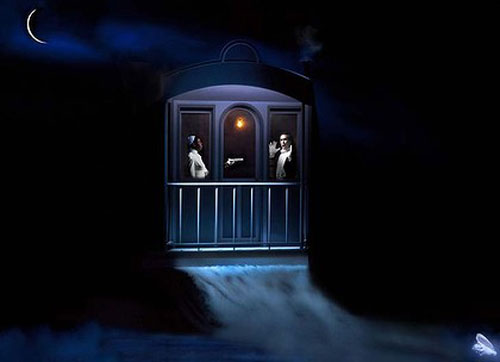 |
I was surprised how American it all seemed this time around. The boy on the crane looked like a black boy; the cartoonish steam locomotive looked ready to conquer a Brave New World with the dancer (Katie Dorn replacing Lucinda Childs) doing her cheerleading best, stepping up triumphantly for "progress" to begin. Something oddly optimistic comes across in the modern dance interludes, now choreographed by Lucinda Childs for a dozen dancers. In ever new patterns of repeated simple steps, they twirl around the stage at amazing speed and with amazing rhythmic precision, like little humanoids or mechanical tops, bathed in light. In the last act, after moments of chaos and an allusion to Einstein's mathematics as a source of the atomic bomb, the final tableau has a big, cartoonish Grey Hound bus rolling in. After the silently puffing train driver, now a bus driver. The bus driver speaks; he delivers a little speech about love. What he says could be perceived as the last ironic word about "progress" -- or as a sappy sermon for the Aquarian Age.
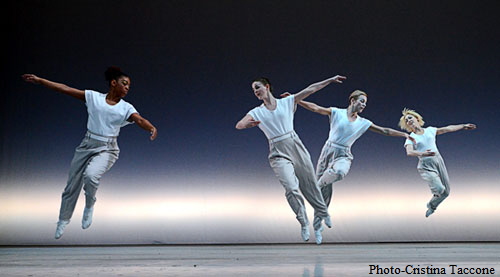 |
Language, one of Wilson's major themes, is always under investigation, whether it is spoken, silent or sung. "Words for Bob are like tacks on the kitchen floor in the dark of night and you're barefoot," Tom Waitts, the singer/songwriter and occasional collaborator of Wilson, once said. "So Bob clears a path he can walk through words without getting hurt. Bob changes the values and shapes of words. In some sense they take on more meaning; in some cases, less." The words used in Einstein are absurd and funny bits of banalities in the trial scenes (the whole libretto of Einstein would fill two or three pages). A series of numbers "one-two-three-four" and solfège syllables "do-re-mi" are sung repeatedly by the small chorus as if conveying an urgent message to humanity. "When numbers are used," Philip Glass explained, "they represent the rhythmic structure of the music. When solfège is used, the syllables represent the pitch structure of the music. In either case, the text is not secondary or supplementary, but is a description of the music itself."
In the second trial scene, speech takes center stage. A monologue is vaguely heard from an elegant woman (Kate Moran) lolling on a bed below the judges' bench. Little by little the repetitions cluster into understandable words. 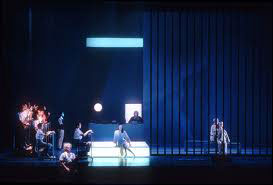 Little by little they form a patchwork resembling coherent speech, and then they acquire grammar and meaning. In the end, one has pieced it together: the long monologue consists of just a few soap-operatic sentences (written by Lucinda Childs) repeated over and over. "I was in this prematurely air-conditioned super market and there were all these aisles and there were all these bathing caps that you could buy which had these kind of Fourth of July plumes on them they were red and yellow and blue I wasn't tempted to buy one but I was reminded of the fact that I had been avoiding the beach." It's a tour de force, ended by the woman's sudden transformation into Patty Hearst, wielding a machine gun. The excitement for the listener lies in the initial impression that an intimate confession is being made in court; the confessional or "story telling" voice leads to expectations. Will a crime of passion be revealed or the primal scene unveiled? The trickery and subversion of the text reminded me of another Wilson piece that I saw performed in Paris in the seventies, titled I Was Sitting On My Patio This Guy Appeared I Thought I Was Hallucinating. In this performance piece, Wilson unemotionally recited a seemingly unengaging text and the same text was then repeated by Lucinda Childs with an emotional affect. The text was practically unrecognizable. (The piece is also being considered for a revival.) In Einstein, the artful, deceitful deconstruction and delivery of the banal remarks turns them into a music of syllables, a long "aria" in speech-form, filled with melodious beauty and imaginary, if inexistent, meaning. Little by little they form a patchwork resembling coherent speech, and then they acquire grammar and meaning. In the end, one has pieced it together: the long monologue consists of just a few soap-operatic sentences (written by Lucinda Childs) repeated over and over. "I was in this prematurely air-conditioned super market and there were all these aisles and there were all these bathing caps that you could buy which had these kind of Fourth of July plumes on them they were red and yellow and blue I wasn't tempted to buy one but I was reminded of the fact that I had been avoiding the beach." It's a tour de force, ended by the woman's sudden transformation into Patty Hearst, wielding a machine gun. The excitement for the listener lies in the initial impression that an intimate confession is being made in court; the confessional or "story telling" voice leads to expectations. Will a crime of passion be revealed or the primal scene unveiled? The trickery and subversion of the text reminded me of another Wilson piece that I saw performed in Paris in the seventies, titled I Was Sitting On My Patio This Guy Appeared I Thought I Was Hallucinating. In this performance piece, Wilson unemotionally recited a seemingly unengaging text and the same text was then repeated by Lucinda Childs with an emotional affect. The text was practically unrecognizable. (The piece is also being considered for a revival.) In Einstein, the artful, deceitful deconstruction and delivery of the banal remarks turns them into a music of syllables, a long "aria" in speech-form, filled with melodious beauty and imaginary, if inexistent, meaning.
What made this scene particularly American for me was not only the air-conditioned supermarket, but the reference to Gertrude Stein's dictum that language is sound, that all words are (democratically) equal, and that there is no repetition: that repetition necessarily changes the thing that is again and again being said. Stein was right-- and Wilson knew it. He and the other avant-gardists of the New York scene of his youth all knew it. When you recite, "A rose is a rose is a rose is a rose," every one is a different rose. John Cage knew it, the Living Theater had already staged Stein's operas, and later Wilson would stage them, too. Not long after Einstein, I remember discovering Wilson's sound experiments, inspired by Stein, in a Paris exhibition at the American Center. You could listen to Wilson's voice "rapping" on words, saying "hat hat hat hath hat had hat hat has hath hat hath…" in long chains of repetition, just like Stein used to "rap" on Picasso ("Shutters shut and shutters and so shutters shut and shutters and so, and so shutters.")
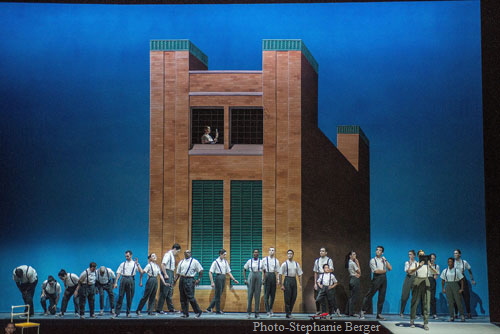 |
Without Stein's inspiration, another scene in Einstein would in fact be unthinkable. The scene is called The Building. A toy-like house-front shows a woman in a "tower" window, counting with her hands. Below her window, one by one, men gather in the street, and just stand there for some length of time, not doing much of anything, until again one by one, they leave and the scene is over. Stein: "It is a much more impressive thing to any one to see any one standing, that is not in action than acting or doing anything doing anything being a successive thing, standing not being a successive thing but being something existing. That is then the difference between narrative as it has been and narrative as it is now."
No matter how tedious at times, the congruency between the repetitive happening-not-happening onstage and the repetitive happening-not-happening in the music creates a "being something existing" that is hard to define, but is thrilling in its hypnotic presence. I felt both strained and elated coming out of the theater. Thrilled to witness that this new narrative of then is still the narrative par excellence of now.
Cover Photo-Lucie Jansch
|
|